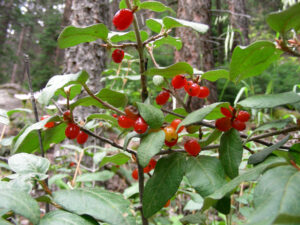by Max Kornetzke, Land Manager
 Russet Buffaloberry (Shepherdia canadensis) is a small to medium-sized shrub that can be found along the shores of each Great Lake, most Canadian provinces, and the montane regions of the American West.
Russet Buffaloberry (Shepherdia canadensis) is a small to medium-sized shrub that can be found along the shores of each Great Lake, most Canadian provinces, and the montane regions of the American West.
Buffaloberry is an early flowering shrub in the Great Lakes region, usually producing its tiny, easy-to-miss yellow flowers along the leaf axils in late April or early May. Male and female flowers are on separate plants meaning multiple plants are needed to bear the small, speckled red fruit. The fruit is edible and ripens in July. I found them to be pretty bitter; however, apparently in areas where fruit is around long enough for a frost, they become naturally sweetened.
The fruit, bark, and roots were all used for various food and medicinal purposes by many indigenous groups across this plant’s native range. One notable food was a kind of “ice cream” produced by whipping the berries up into a froth (due to high saponin content) and depending on how bitter or sweet the berries were, adding a sweetener.
The leaves have a beautiful dark green on the upper side and a dotted russet color on the under, hence one of its common names, Russet Buffaloberry. It will form colonies and grow underneath other larger shrubs and trees with dappled shade.
Like many other members of the oleaster family (Elaeagnaceae), buffaloberry fixes nitrogen, making it ideal for soils with poor nutrient content, like the stabilized sand dunes along Lake Michigan.
Although locally common, it does not extend very far into the state’s interior. You may be more likely to encounter its non-native, invasive cousin with somewhat similar leaf and berry characteristics, the autumn olive (Elaeagnus umbellata).
If you wish to see buffaloberry in flower or observe its unique leaf color, you can find a few specimens growing along our Horsetail Loop. I’ve also observed this plant growing underneath pines just before the dunes habitat at Point Beach, as well as growing under various larger shrubs and trees at Schuette Park.
photo by Lady Bird Johnson Wildflower Center
